Namibia, 2017: Not The Big 5
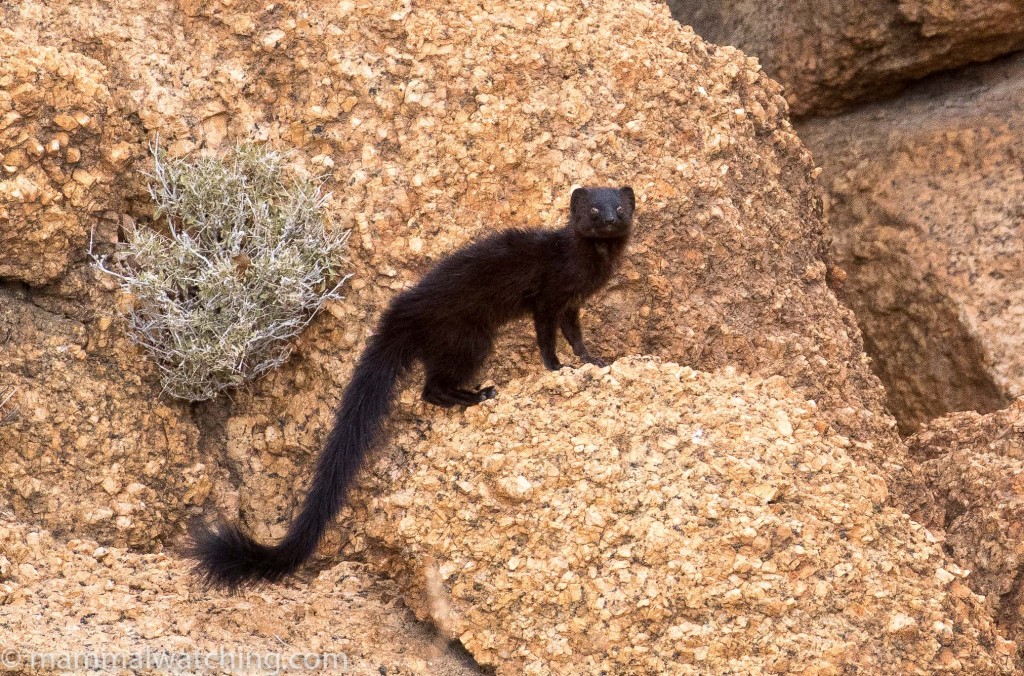
Black Mongoose, Galerella nigrata
In December 2017 I returned to Namibia for a work trip and of course took a few extra days to look for some mammals.
Namibia is every bit as beautiful as I’d remembered from my 2008 visit. The only change I noticed was a sharp increase in the numbers of tourists in self-drive 4WD safari camping vehicles. I opted for a bargain basement 2wd VW which was fine on the excellent gravel roads, though a 4×4 would have been useful in Swakopmund had I wanted to drive into the desert.
My main target was a Black Mongoose, which – depending on whose taxonomy you believe – are endemic to Namibia. There has been considerable debate about the validity of this species but I think it is now broadly accepted that Black Mongooses are not just a colour morph of the Slender Mongoose, or any other mongoose come to that. The IUCN, as of late 2017, treats the Black Mongoose (Herpestes flavescens) as the species found in both Angola and Namibia, though noting that there are apparently differences between the blackish Namibian animals and the brown Angolan animals, and that they may comprise two species. I’m going with the two species arguments and believe the true Black Mongoose is Galerella nigrata, a Namibian endemic.
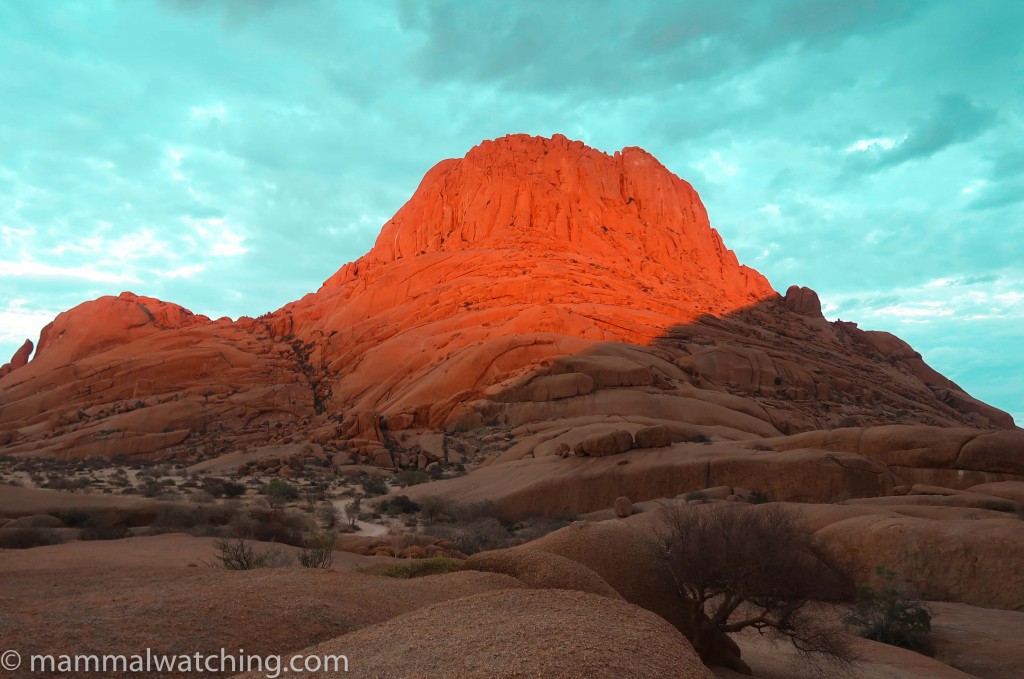
Spitzkoppe
Mongooses aside, I wanted to see some new bats and rodents and meet up with Mike Richardson and Sarah Winch who were in the country on vacation. So I spent four days in the narrow strip of Namibia between Windhoek and Swakopmund.
Eningu Lodge
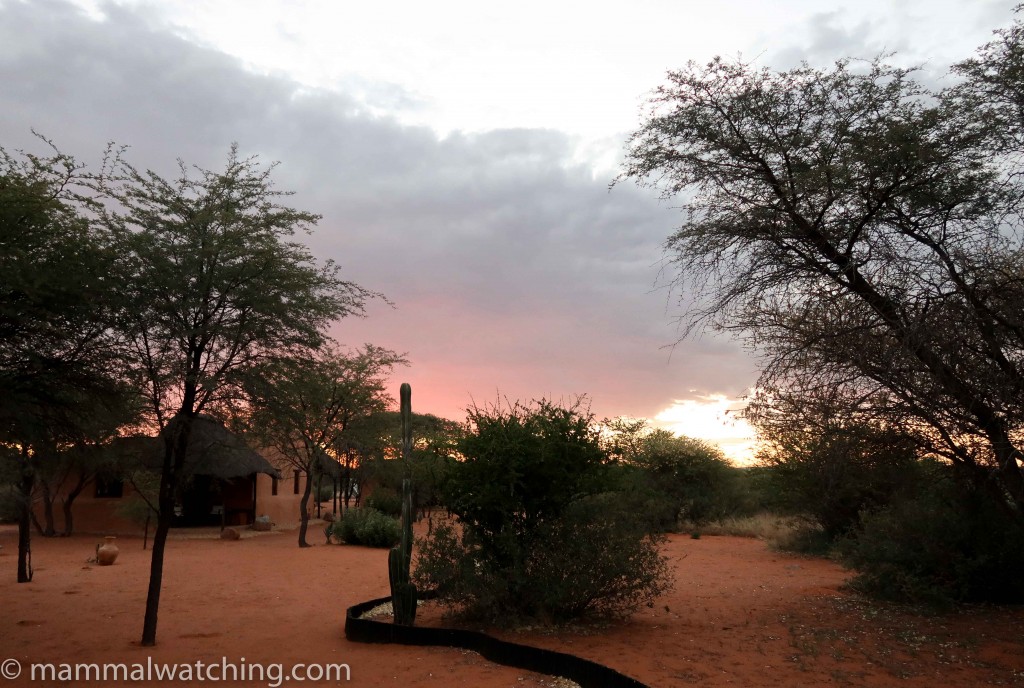
Eningu Lodge
Eningu Lodge, like so many places in Namibia, combines comfortable rooms with good food and wilderness. It is only an hour or so east of Windhoek airport and I spent a night here because it was close to Arnhem Cave. I wasn’t expecting to see much so was delighted to spot a couple of Black-tailed Tree Rats in the thorny trees next to the lodge at sunset.
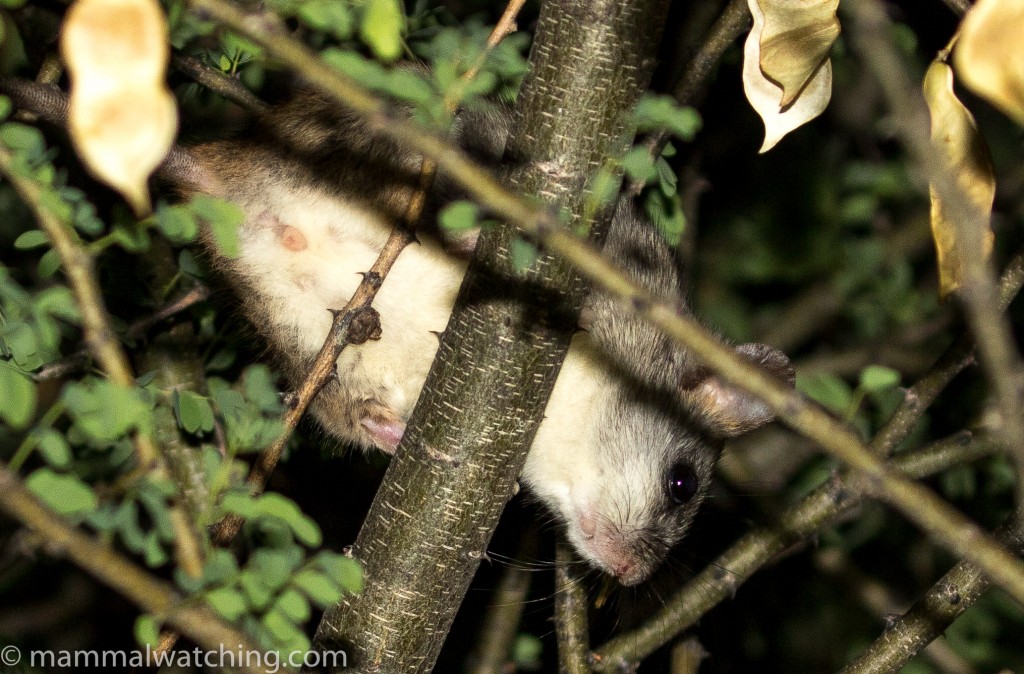
Black-tailed Tree Rat, Thallomys nigricauda
Steenboks and a Warthog came into drink from the small floodlit waterhole that evening, though I didn’t see the Porcupines that are regular visitors.
I noticed some small bats flying around the dining room doors and closer inspection showed they were roosting in the cracks of the wooden door frame. I couldn’t catch any but managed to take some very bad pictures with my phone. So far as I can tell – and after discussion with the guys from AfriBats – I think they are probably Cape Serotine Bats (Neoromicia capensis).
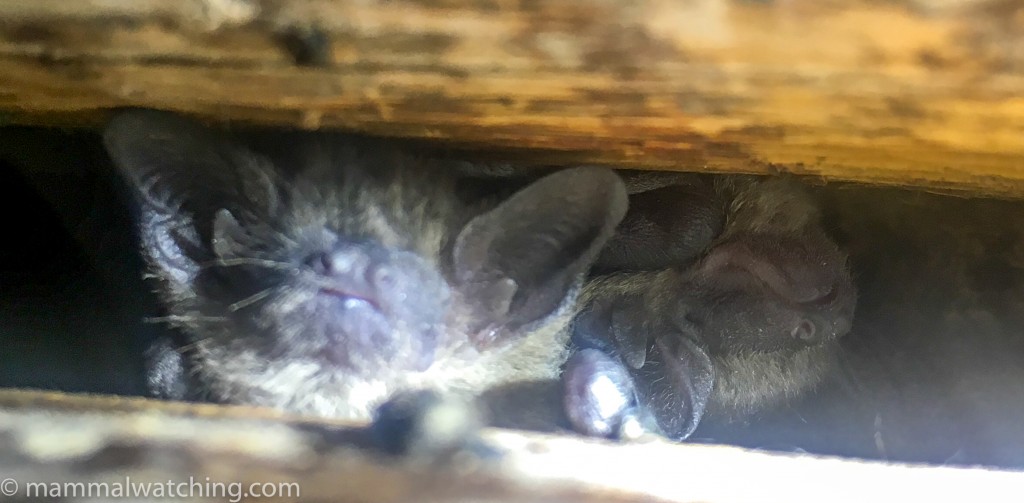
Cape Serotine, Neoromicia capensis
I set some Sherman traps in the bush and caught three Multimmate Mice. According to this research the animals in the dry centre and south of Namibia are all Mastomys coucha. My third lifer at Eningu.
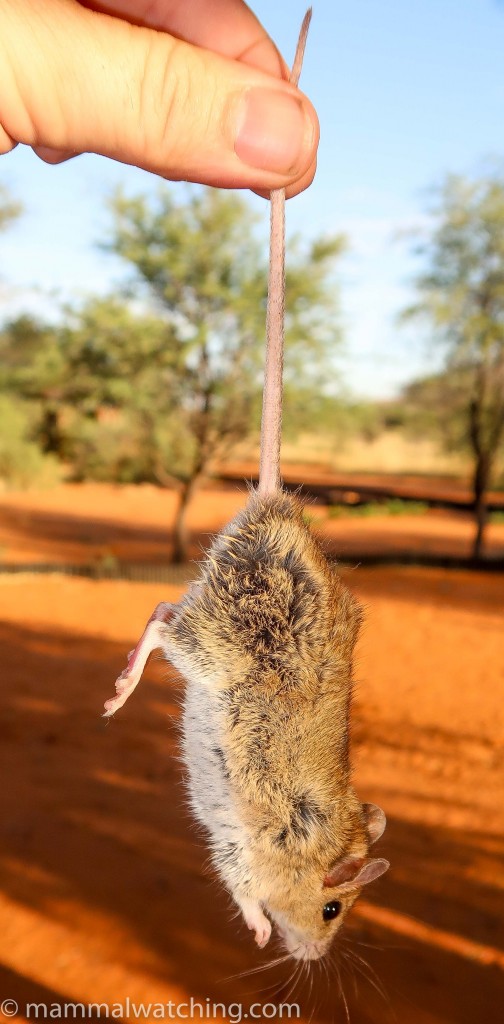
Southern African Mastomys, Mastomys coucha
My only other capture was a Bushveld Gerbil. Cape Ground Squirrels were plentiful around the accommodation too.
Arnhem Cave
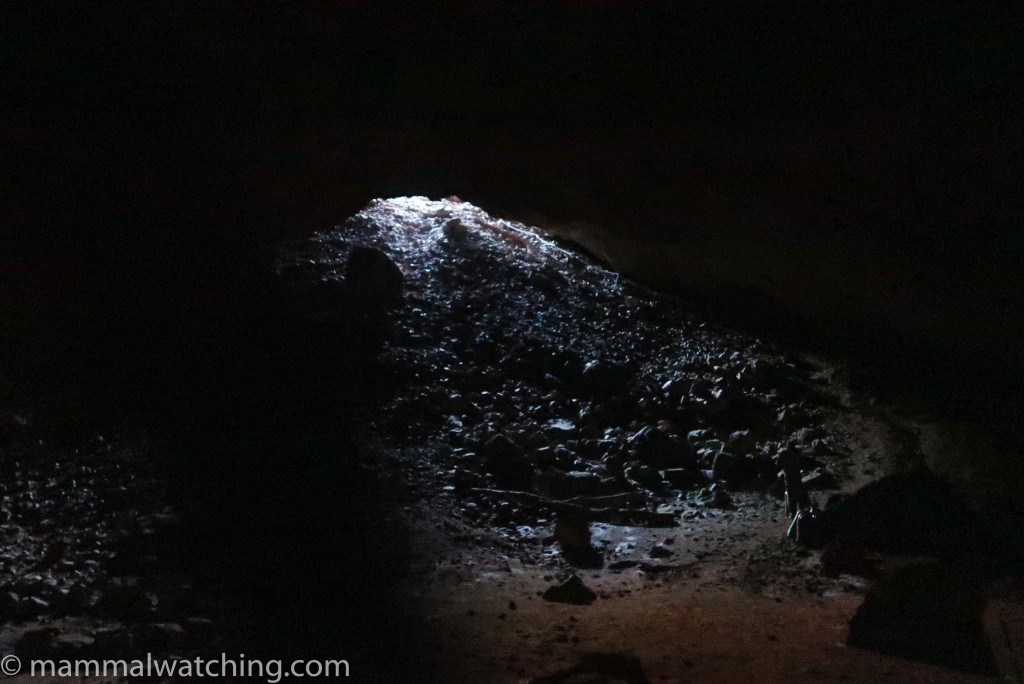
Arnhem Cave
Several Namibian scientists gave me advice before I arrived and Angela Curtis, a bat researcher at the Gobabeb Research Centre, was particularly helpful. She recommended Arnhem Cave as a good spot to see several bat species.
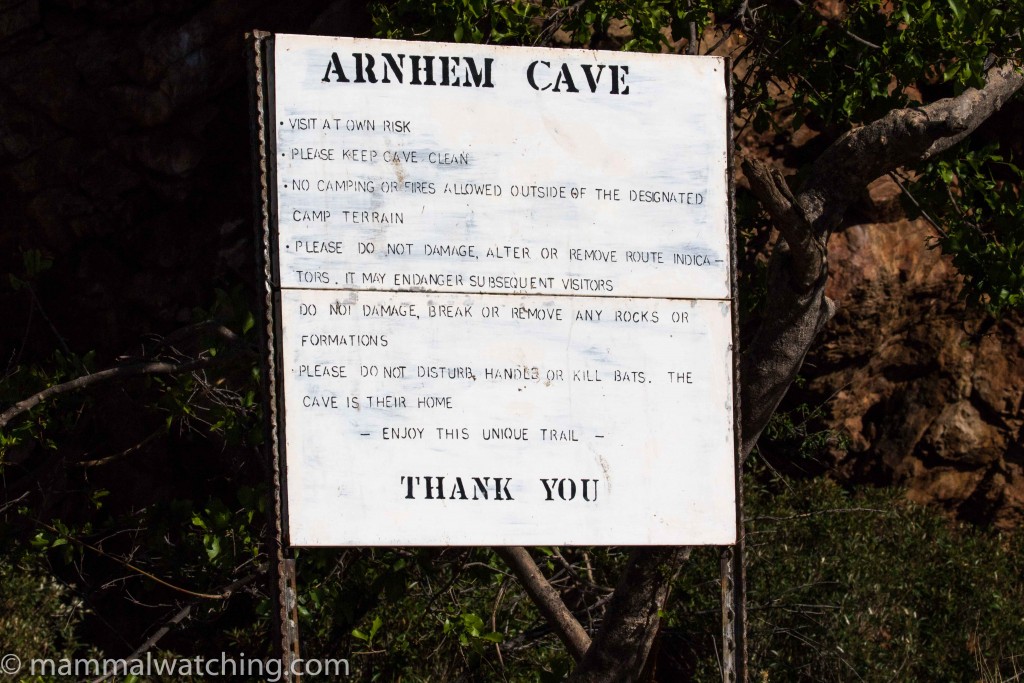
Arnhem Cave is in a low key self-catering lodge/rest camp about 90 minutes from Windhoek Airport. If you want to visit the cave it seems to important to contact the lodge in advance to ensure the gate is open and someone will be there when you arrive. I got in touch via their Facebook page.
I arrived at 8 a.m. One of the locals – “Boy Boy” – was summoned to be my guide and off we went. It is a 15 minute walk to the escarpment and the mouth of the cave. Access throughout the cave is easy – I think I had to duck my head just once – though there are several ladders to climb and I wished I’d stuck my camera in a backpack. We spent a little over 2 hours inside and saw all six species that Angela told me roosted there.
We explored the the Second Stage first and saw hundreds of Egyptian Slit-faced Bats.
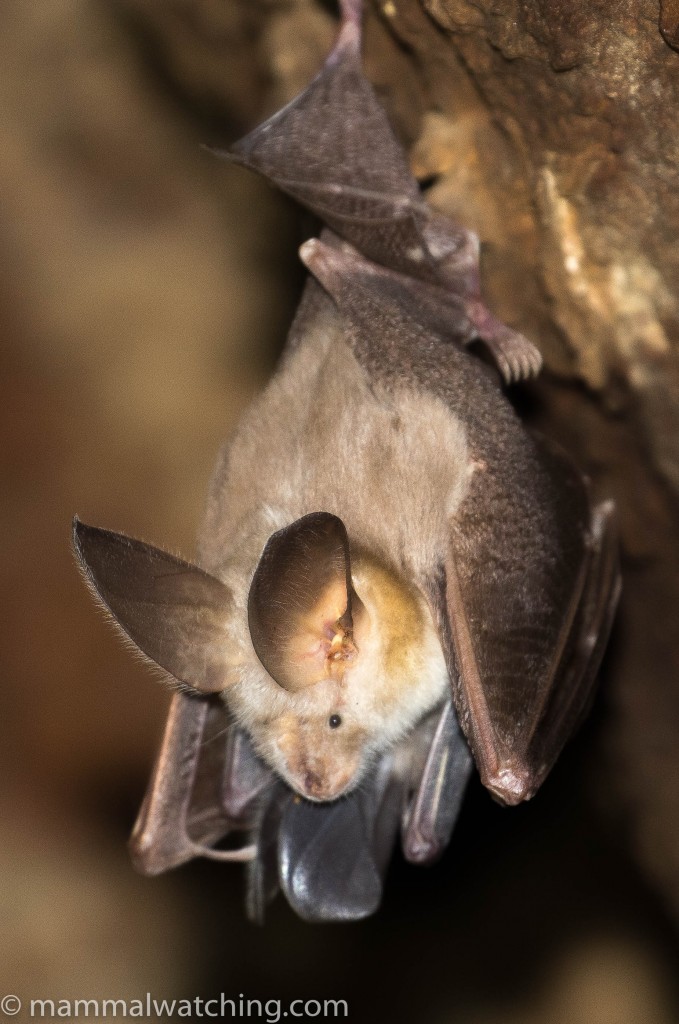
Egyptian Slit-faced Bat, Nycteris thebaica
There were also scattered groups of horseshoe bats, all the same species I think: Dent’s Horseshoe, the smaller of the two horseshoe bats that live in the cave. Towards the end of the Second Stage we found a small group of the robust Striped Leaf-nosed Bats, a very impressive bat and the largest insect-eating bat in the region.
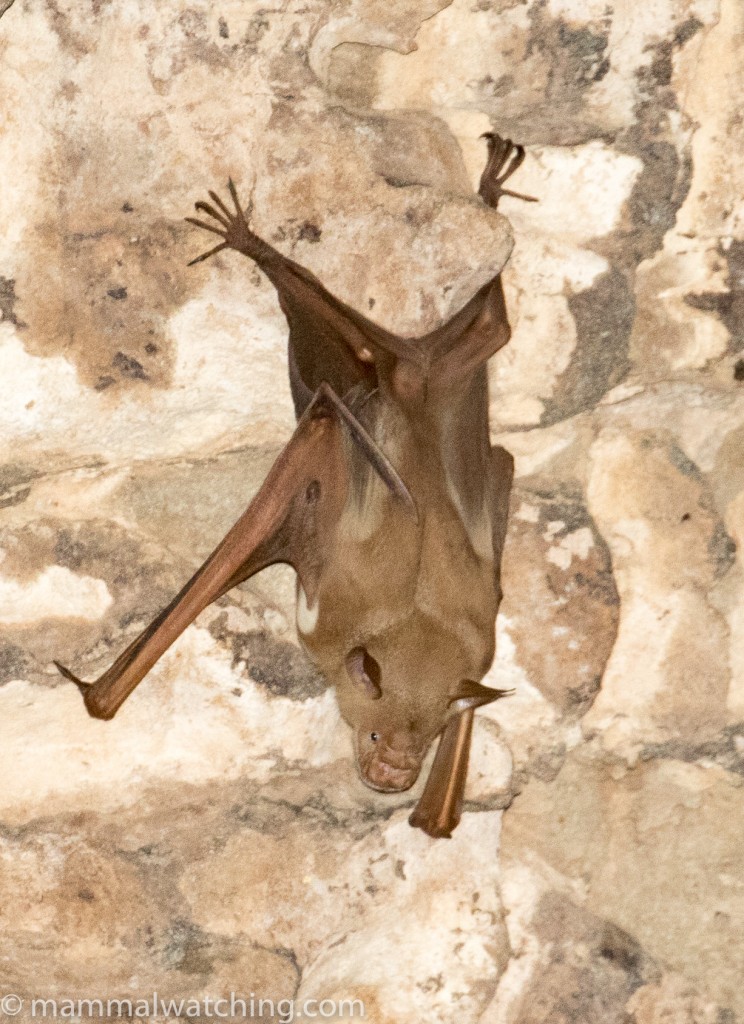
Striped Leaf-nosed Bat, Hipposideros vittatus
Moving into the First Stage of the cave there were more Egyptian Slit-faced Bats, and dozens of Sundevall’s Roundleaf Bats.
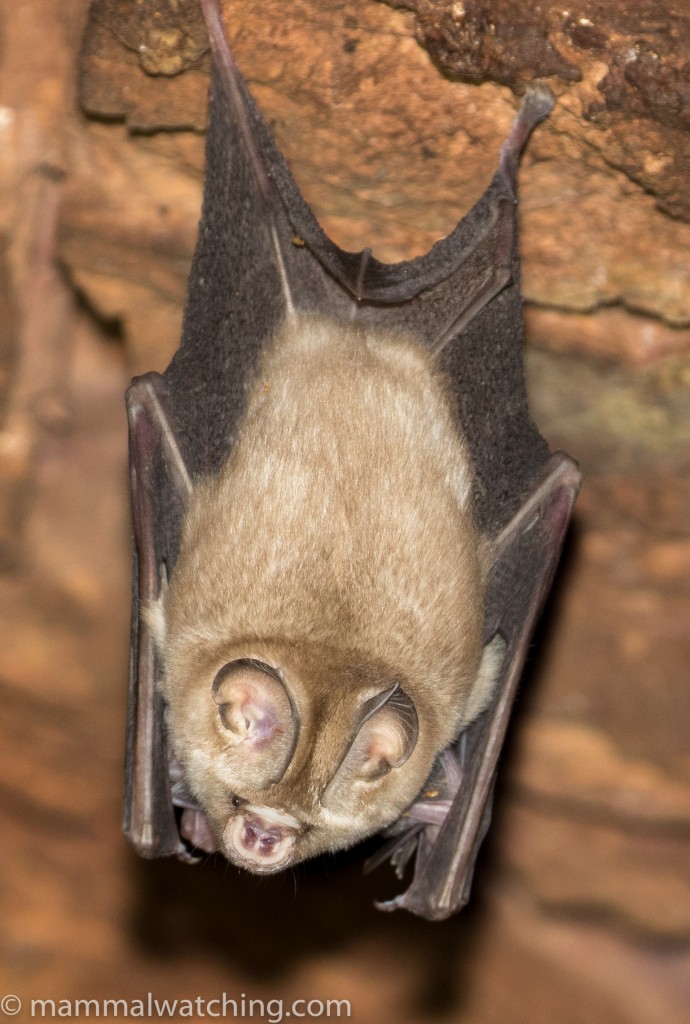
Sundevall’s Roundleaf Bat, Hipposideros caffer
There were also more horseshoe bats. Two species roost in the cave, according to Angela, but they are not particularly easy to tell apart unless you see them side by side. Most, I think, are the smaller species, Dent’s Horseshoe Bat.
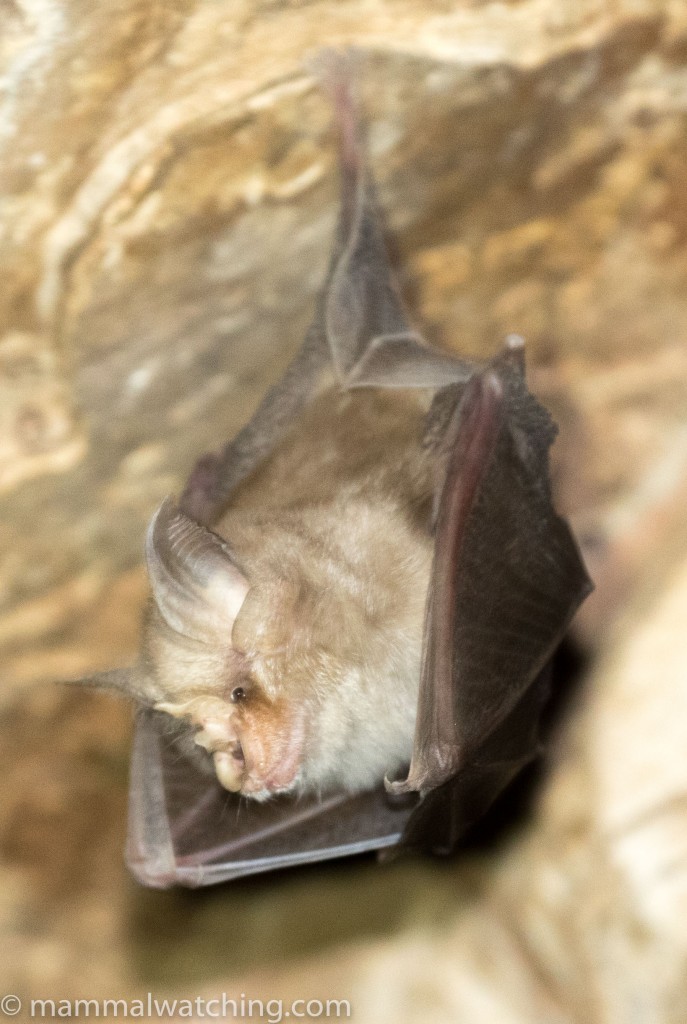
Dent’s Horseshoe Bat, Rhinolophus denti
The larger species in the cave are Damara Horseshoe Bats, a fairy recent split from Darling’s Horseshoe Bat. And I saw a few animals, particularly at the end of the trip, that seemed to be this species. As always very happy to receive corrections to my IDs.
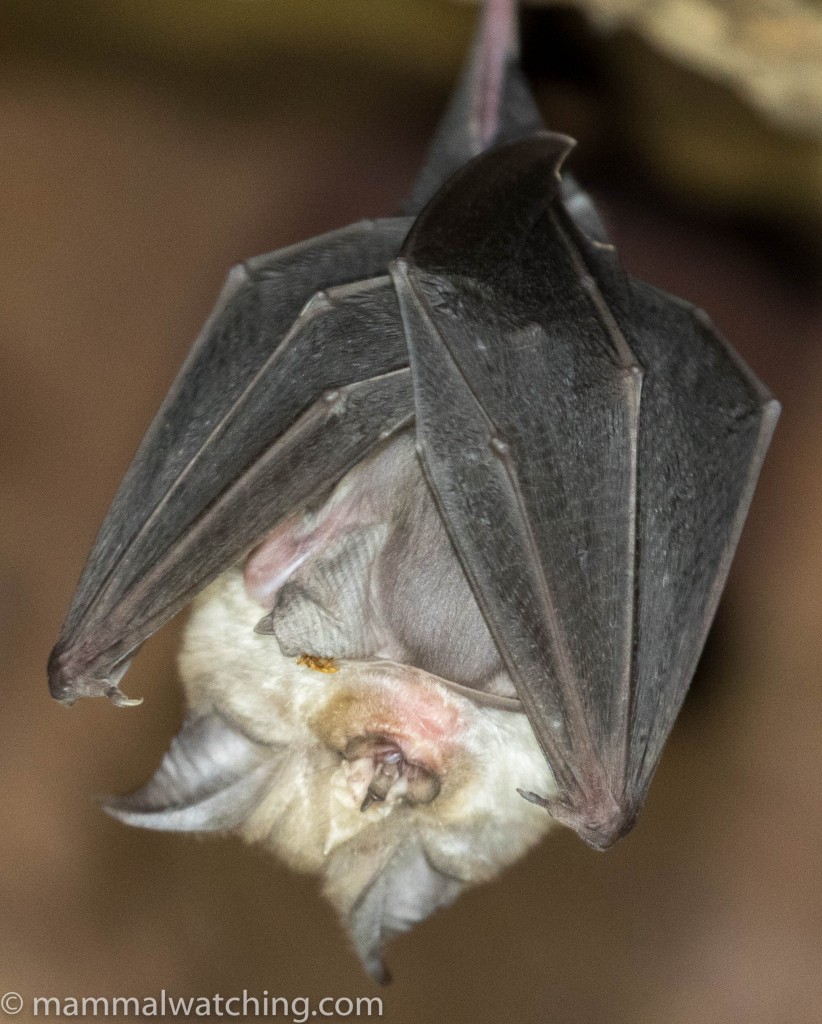
Darling’s Horseshoe Bat, Rhinolophus darlingi
The sixth, and final species, was a huge, stinky, colony of Natal Long-fingered Bats. This was a maternity colony, though I think the bats are always here, and it was spectacular. At first I thought the walls of the cave had been stained pink with some sort of mineral.
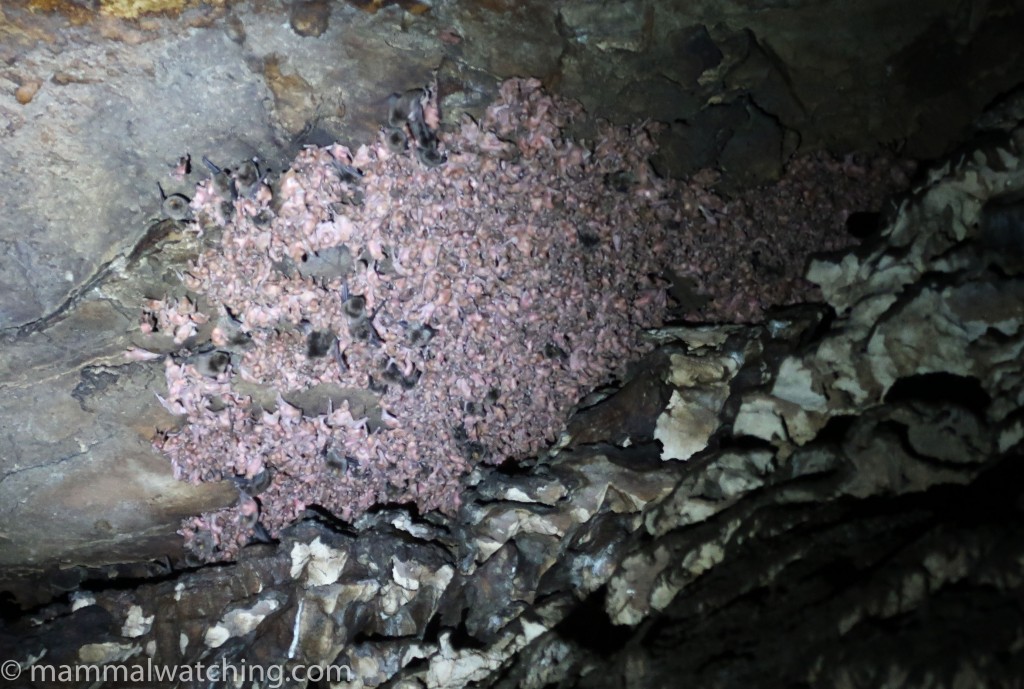
Natal Long-fingered Bat nursery, Miniopterus natalensis
But on closer inspection the pink rocks were – in fact – a seething mass of baby bats.
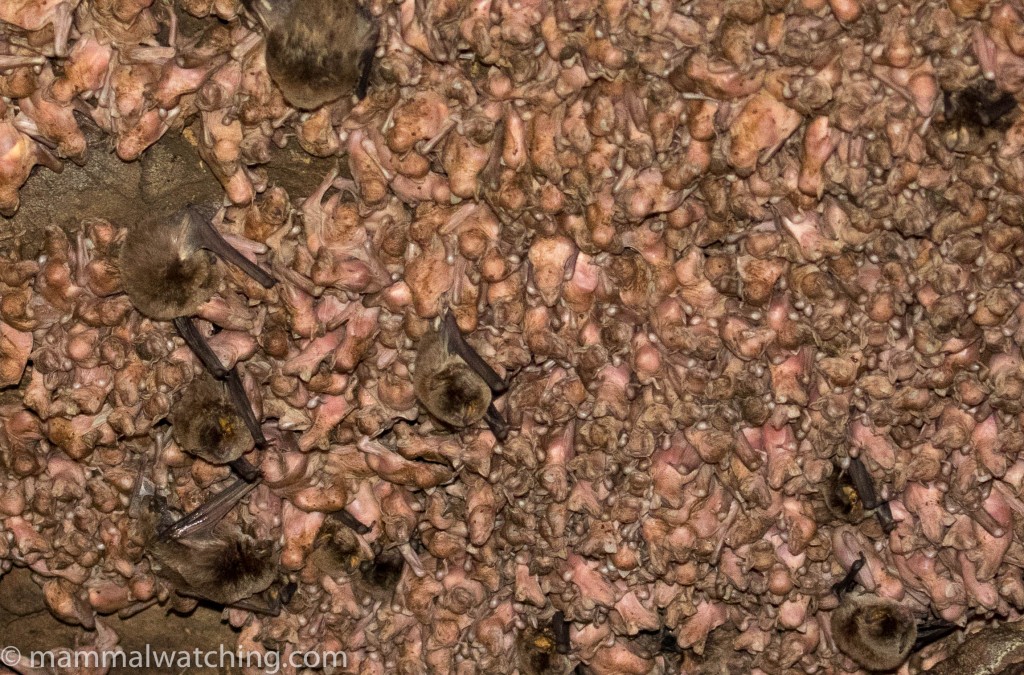
Natal Long-fingered Bat nursery, Miniopterus natalensis
The stench was almost unbearable.
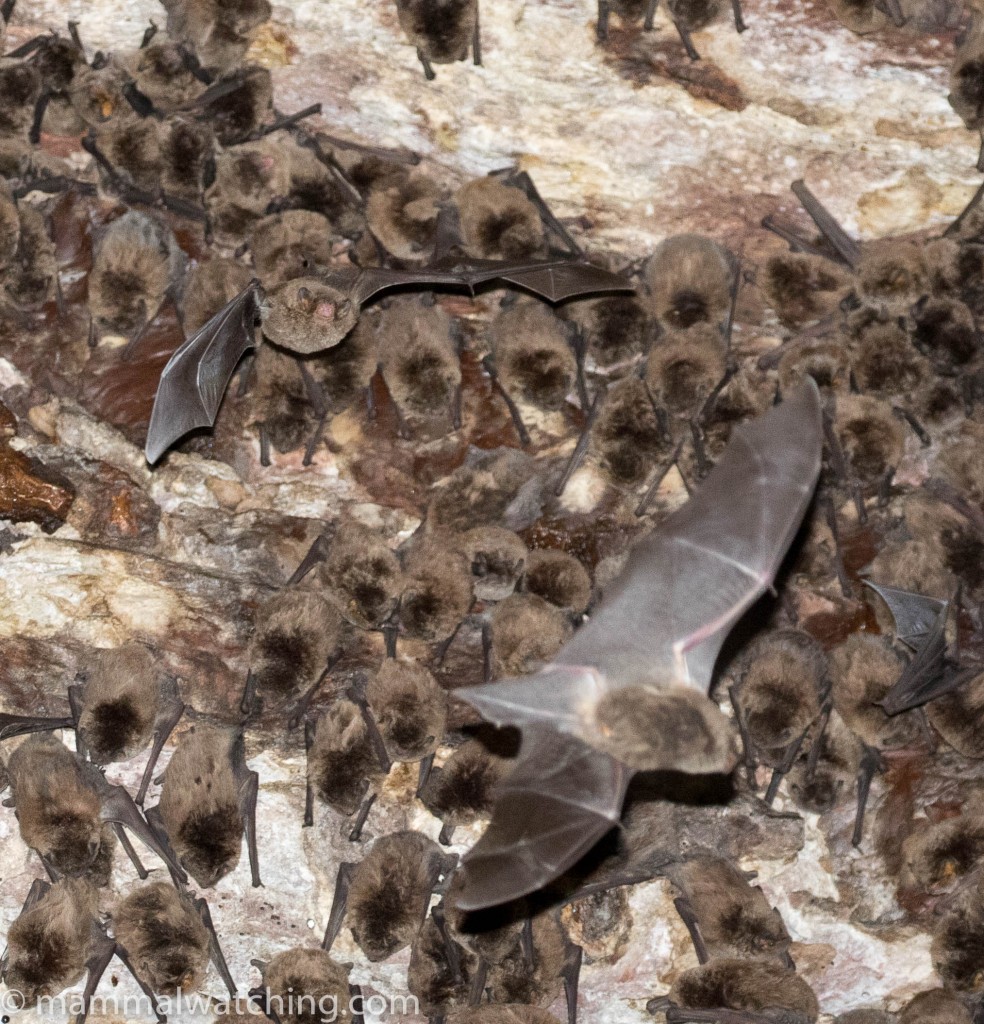
Natal Long-fingered Bats, Miniopterus natalensis
Arnhem Cave is the biggest cave system in Namibia and, if you are into bats, a great way to spend a morning. In a little under three hours I saw six species, four of which were new. In addition to the bats there are Rock Hyraxes at the entrance and several mummified Porcupines deep inside the cave.
Erongo Wldnerness Lodge

Erongo Wildnerness Lodge
Erongo Wilderness Lodge is spectacular. I’d visited here with my family in 2008 looking for Dassie Rats, Rock Elephant Shrews and Black Mongooses. I hadn’t seen the mongooses so wanted to return, particularly after Matt and Maureen Steer saw Black Mongooses here in October 2017.
Many years ago I think the mongooses used to be regularly visitors to the camp kitchens. But that is no longer the case. Black Mongooses are still around though, and most people I talked to at the lodge said the same thing: they might see one every week or two but it was very hard to predict where and when.
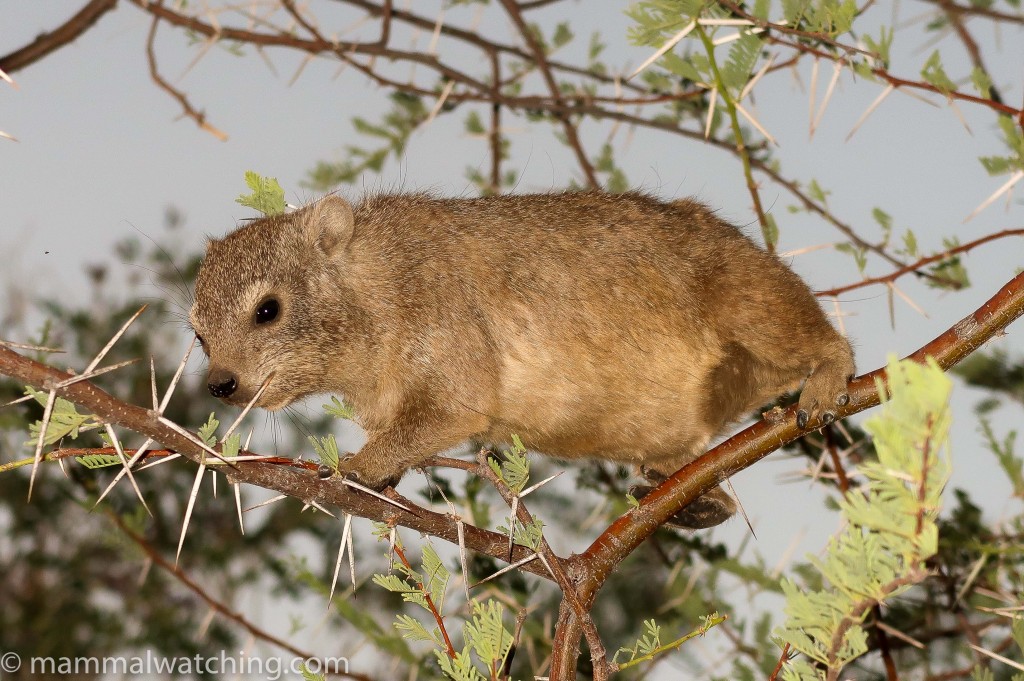
Rock Hyrax. Procavia capensis
Rock Hyraxes are, however, abundant. And if you don’t see one of these you might as well hang up your binoculars for good.
Habituated Dassie Rats, another Namibian specialty mammal, were also easy to see near to the restaurant and swimming pool.
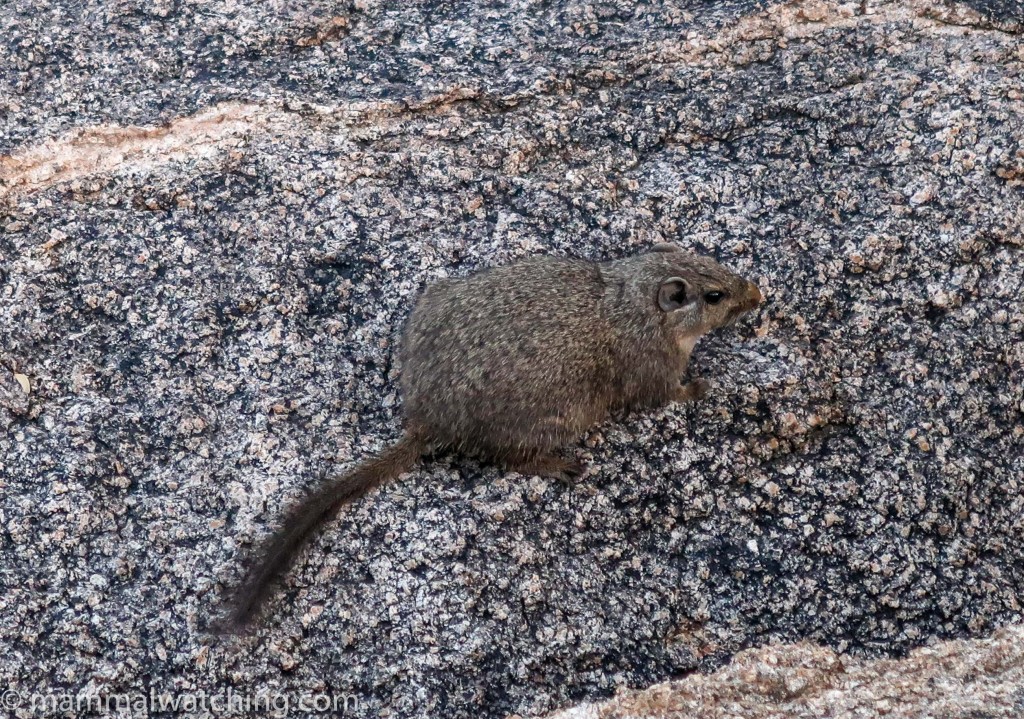
Dassie Rat, Petromus typicus
I didn’t look for Western Rock Elephant Shrews this time but was told that Bushveld Sengis (Elephantulus intufi) are quite common in the grassy areas. Indeed one of the kitchen staff had seen one early that morning. I was too busy looking for mongooses to try.
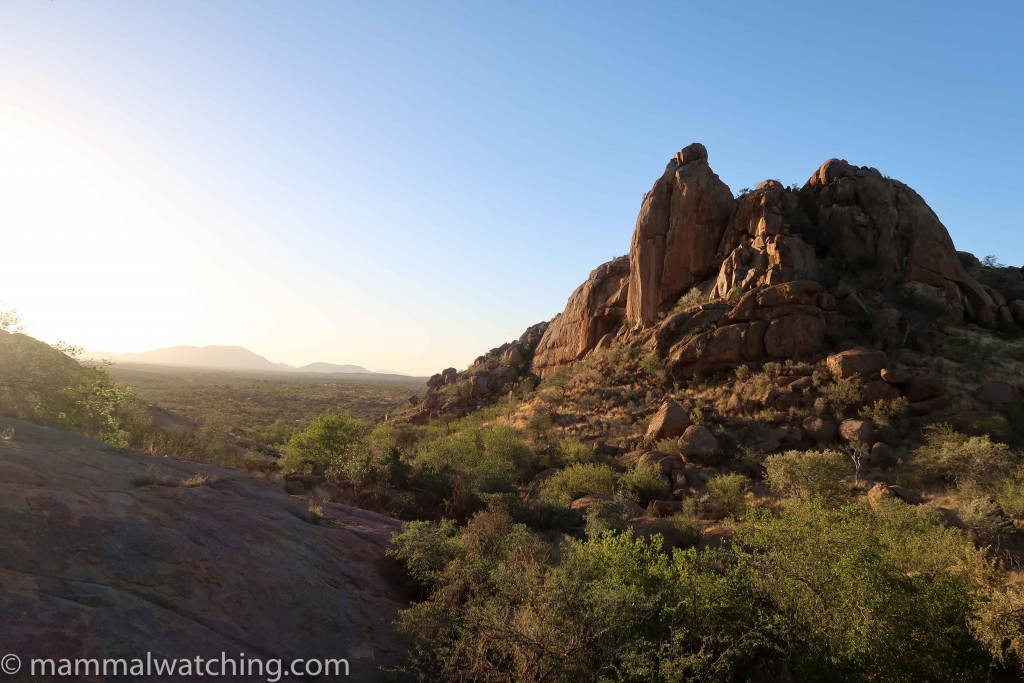
Looking for Black Mongooses
I spent three hours from dawn looking for Black Mongooses. I tried a number of vantage points and eventually decided the rocky hill immediately north west of the camp gates was as good as any. It offered a decent overlook of the slopes around my cabin – Cabin 10 – where I was told the mongooses are seen fairly regularly. I wasn’t lucky, but there are worse spots to sit and contemplate the universe.
I’d gotten permission to set some Sherman traps around the lodge. As expected most captures were Namaqua Rock Mice, which are abundant here.
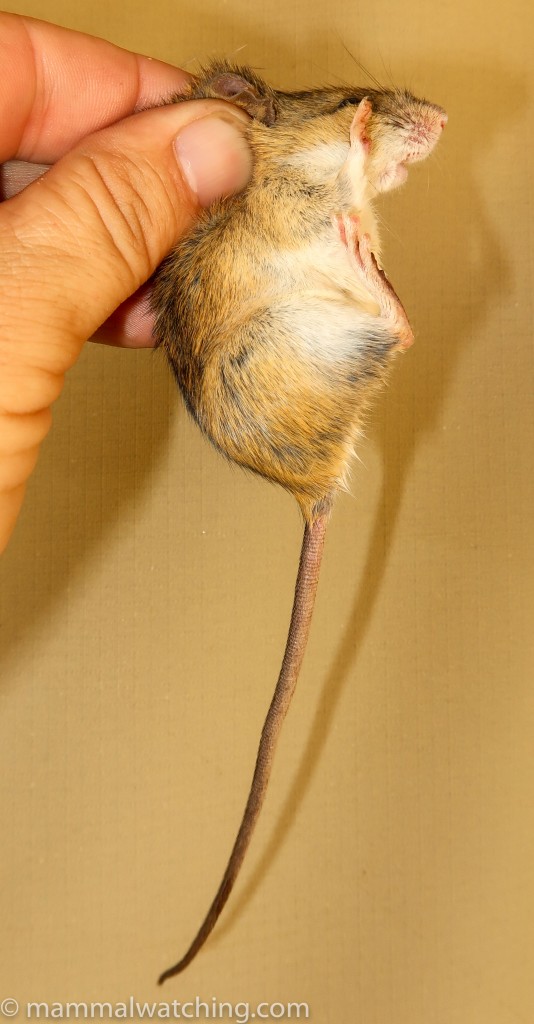
Namaqua Rock Mouse, Micaelamys namaquensis
On the advice of Galen Rathbun, who has done a lot of trapping at Erongo, I focussed on the cracks between boulders in the hope of catching a Pygmy Rock Mouse. And I got lucky.
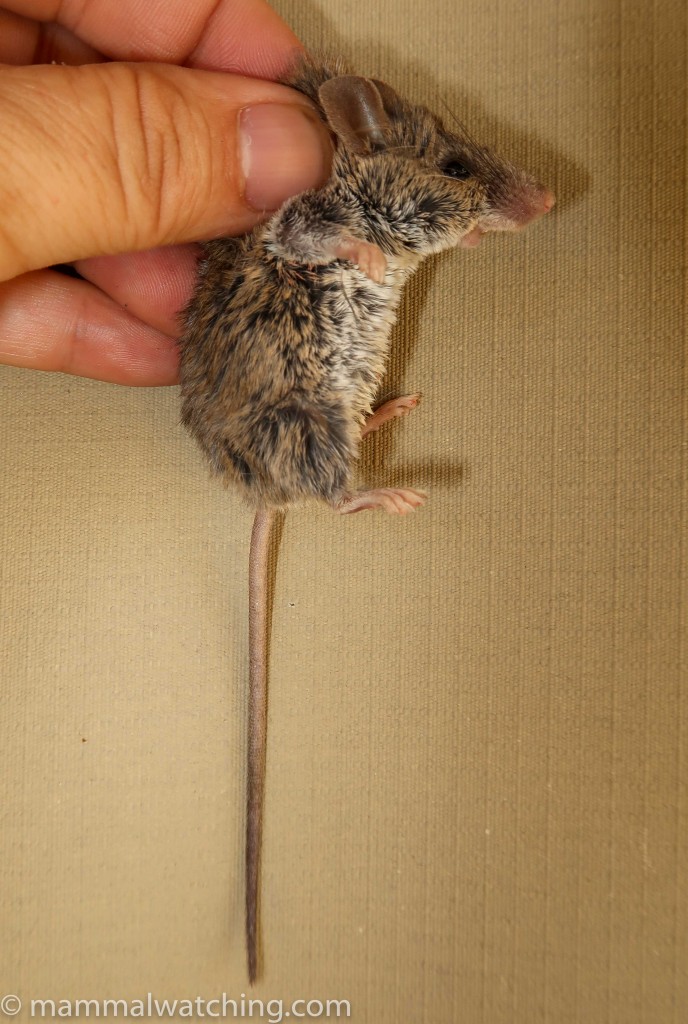
Pygmy Rock Mouse, Petromyscus collinus
No Black Mongoose perhaps, but it is such a lovely lodge it is hard to leave disappointed.
Spitzkoppe
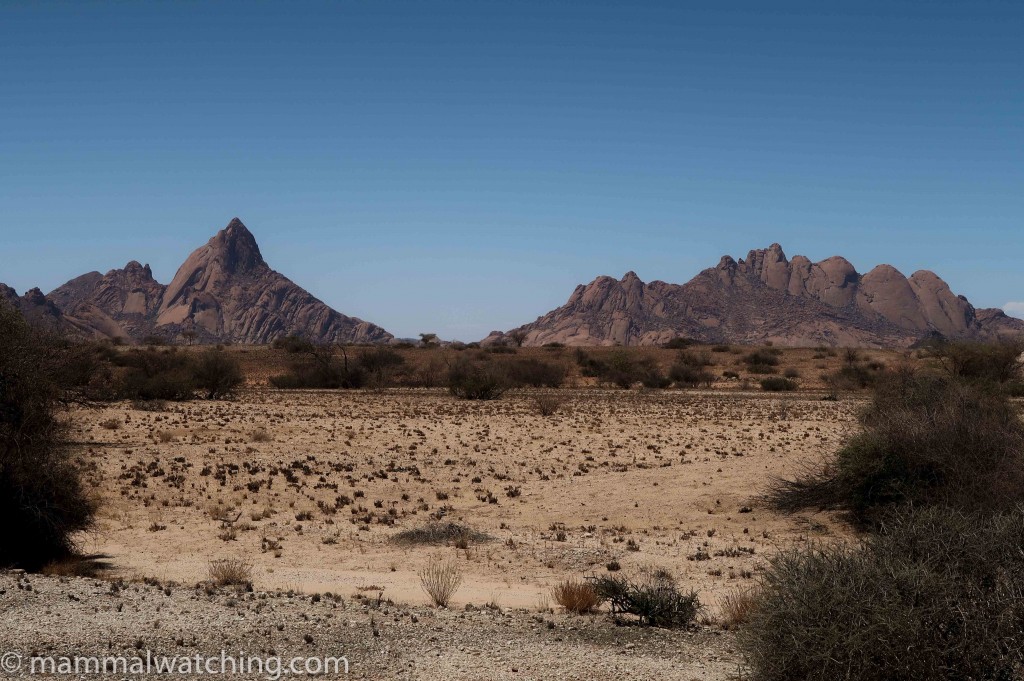
Last time I was in Namibia I’d bumped into Sara Rapson, back then an Australian Phd student working on Black Mongooses. So I tracked her down and asked for her advice on where to look this time. Spitzkoppe, she said, was a good place to see them.
And so Spitzkoppe, Namibia’s answer to Uluru, was my next stop, a little under two hours’ drive from Erongo Lodge.
There is a fancy lodge at Spitzkoppe and also a wonderful cluster of isolated campsites stretched around the rocks as part of a community run campground. When I arrived to check in I was greeted by a guide with that excellent news that every mammalwatcher loves to here “we see Black Mongooses <or insert species here> almost every day”. He advised I look for mongooses around the cluster of sites on the western side of the rocks (sites 9, 10 & 11 I think), or in the area around “Bushman’s Paradise”, which may or may not be twinned with Gangsta’s Paradise.
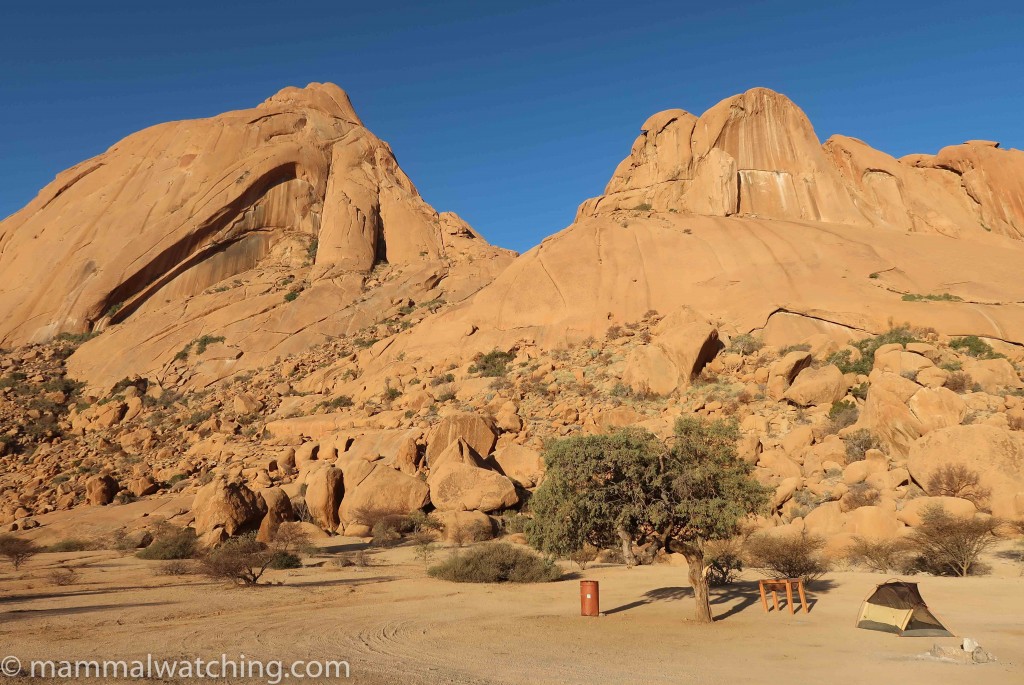
Erongo camping
I loved this place. It’s beautiful, empty and – like so much of Namibia – reminded me very much of Australia.
I wandered around the rocks near my campsite (9a) for a couple of hours in the late afternoon. Cape Ground Squirrels and Rock Hyraxes were common but I didn’t see a mongoose. Just before sunset I drove to the Bushman Paradise area of the park and stopped at a campsite called Smartie. I walked over a couple of the basketball court-sized boulders behind the site and sat for twenty minutes to scan the rocks below me, occasionally squeaking in a way I thought might interest a mongoose.
Sure enough a Black Mongoose appeared, low down among the boulders at the base of the hill. It spent a few minutes cautiously approaching me, presumably inquisitive about the squeaking, and posed obligingly. A great little beast that exceeded my expectations.
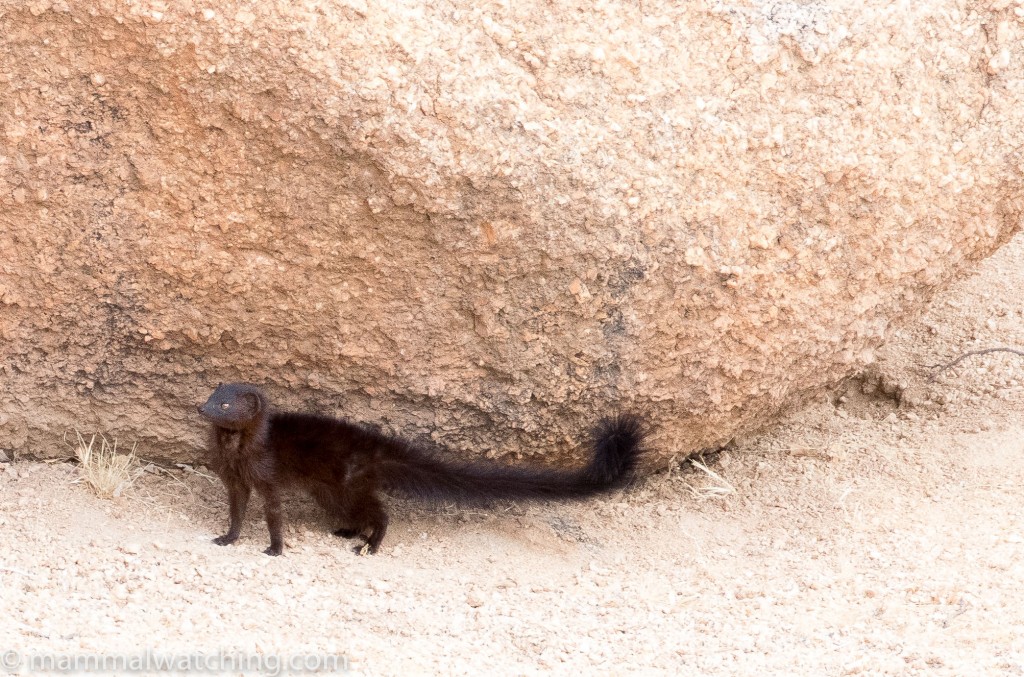
Black Mongoose, Galerella nigrata
I returned at dawn the next day and, after watching a Dassie Rat, saw a mongoose again (likely the same animal I guess). This one gave even better views for five minutes. Many people told me that Black Mongooses are fast, hard to photograph and you often get only a glimpse. I was either lucky or “squeaking them” in is the way to go.
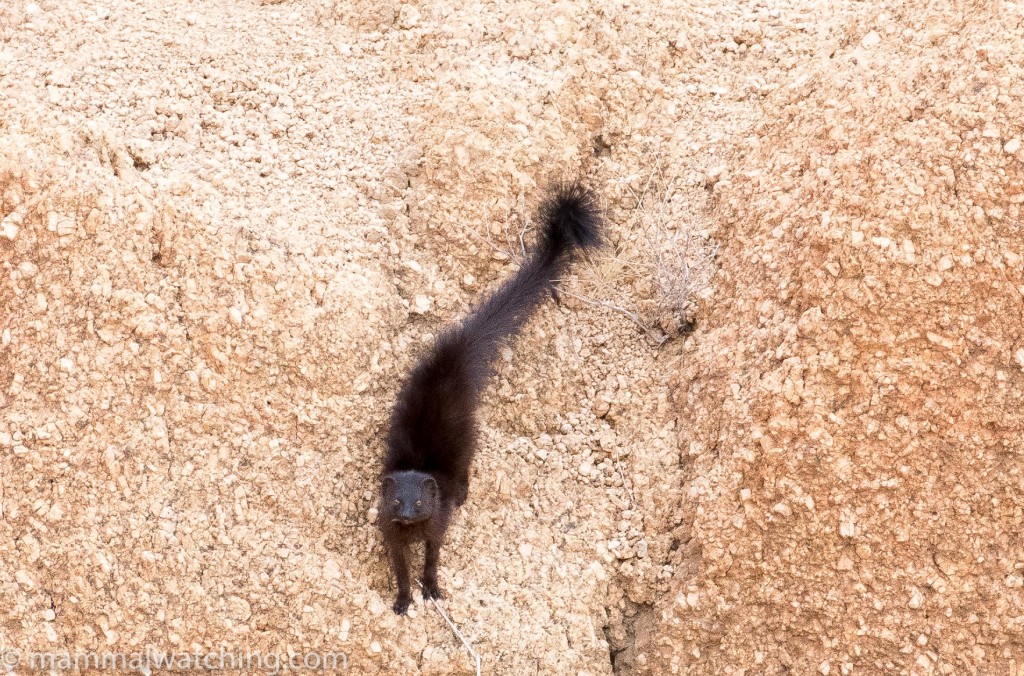
Black Mongoose, Galerella nigrata
I didn’t see – nor look for – much else while I was there. I shone a spotlight out of the window when I drove back to camp from the cafe and saw a Spring Hare, a Cape Hare and a Steenbok.
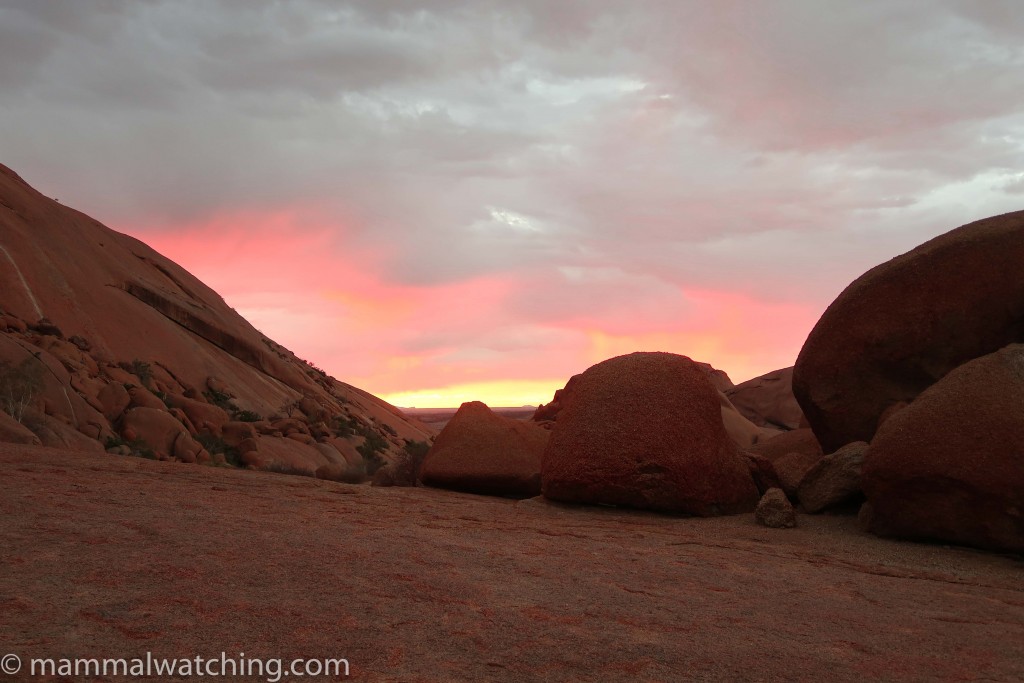
Black Mongoose habitat, near Bushman’s Paradise
As I was leaving the next morning I had a close encounter with a cobra: probably a bit to close after I later learned this was a Banded Spitting Cobra.
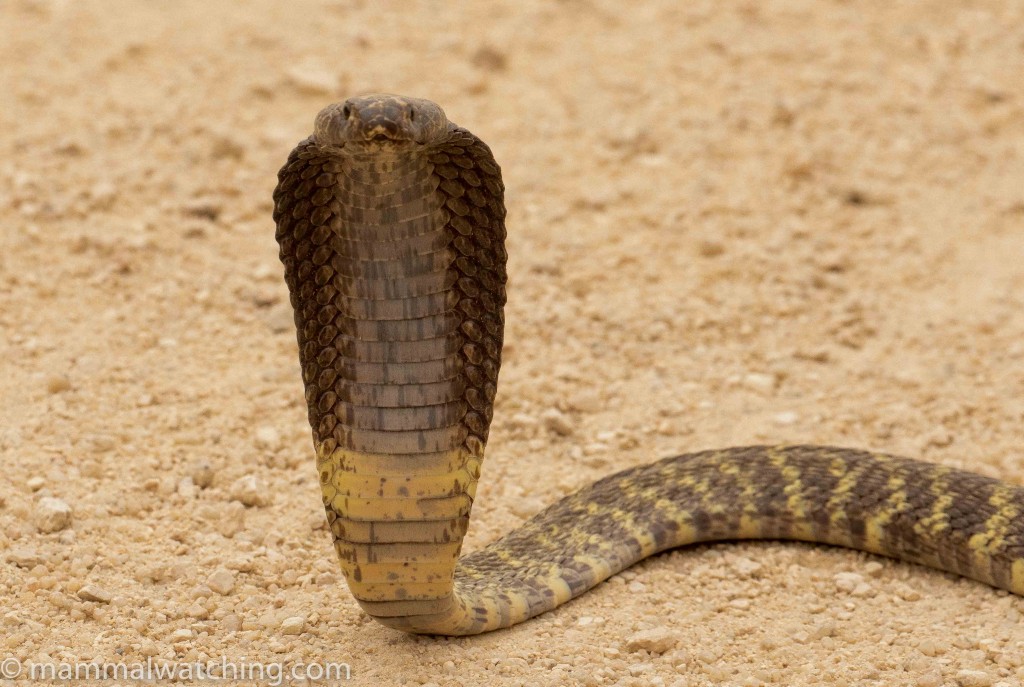
Banded Spitting Cobra
Spitzkoppe is the best place I now know of to see a Black Mongoose and a definite hotspot for the species. It is also a lovely place to visit for its own sake.
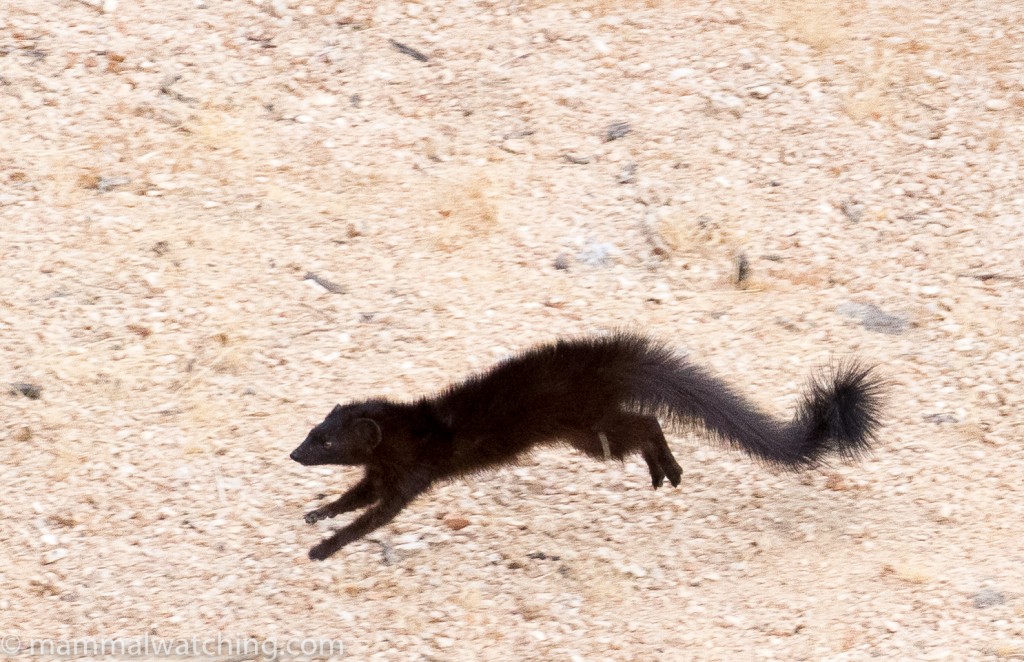
Black Mongoose, Galerella nigrata
Roidina Nature Farm
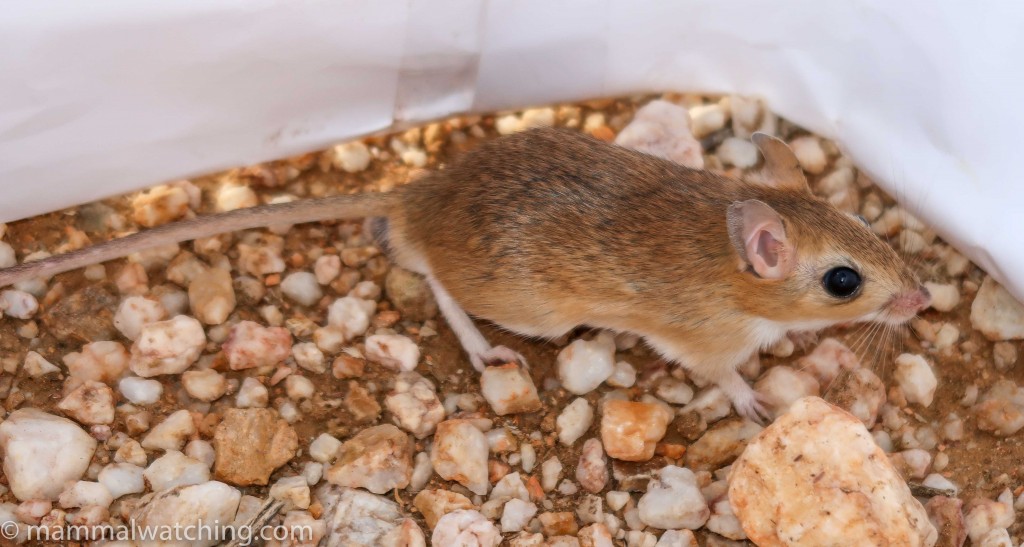
Bushveld Gerbil, Tatera leucogaster
Delighted with my mongooses I drove a couple of hours to Roidina Nature Farm, where I met up with Mike Richardson and Sarah Winch on the last day of their Namibian vacation. I didn’t have much of a plan or target list here so Mike and I set some traps on the farm and visited the rocky site Richard Webb described 20 kms north-west of Omaruru.
At the rocks we saw a Dassie Rat within seconds of arriving. Western Rock Elephant Shrews seemed particularly common there and we must have spotted half a dozen in an hour or two. I did see a mongoose, running through the bush just below the rocks, but it was a Slender Mongoose, not a Black Mongoose. There were also Rock Hyraxes here and Namaqua Rock Mice.
Back at the lodge Mike had spotted a Bushveld Sengi when he was setting his traps before I arrived but we couldn’t catch or see another one. Our only captures that night were several Bushveld Gerbils.
An hour’s spotlighting along the entrance road to the farm produced a Damara Dik Dik, a couple of Bush Duikers and several Cape Hares.
Swakopmund

I spent my final night at Swakopmund, a medium sized town (by Namibian standards) on the coastline where the Atlantic meets the Kalahari.
The desolate coast here is a special place, and also home to some special mammals including Littledale’s Whistling Rat, one or more Round-eared Sengi species and Setzer’s Hairy-footed Gerbil, which has a very restricted range. I was kindly given some GPS locations to look for each species from local naturalist Sean Braine who runs Batis Birding Safaris.
But despite several hours spotlighting that night, and time in the right habitat at dawn and dusk I saw nothing. The Setzer’s Gerbil, in particular, should have been quite easy to see and Trevor Hardaker got nice photos when he was in town. But the huge (almost) full moon that night did not help my chances. In principle the gerbils could be along any of the roads through the desert after dark. And you can try looking in scrub around the Rossmund Golf Course (close to the river) for the Littledale’s Whistling Rats (in the day time). There might be crepuscular/nocturnal Sengis here too.
Somewhere to return to.
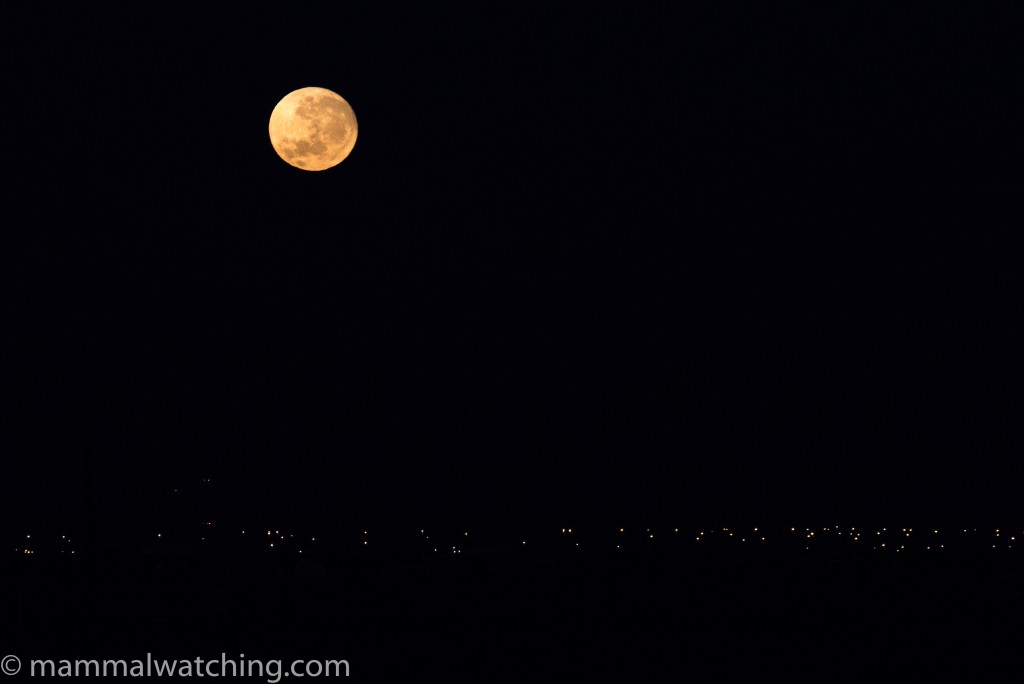
Supermoon over Swakopmund
A fun, and pretty successful, four days given my focussed wishlist. That success was largely because of the help I generously received from Galen Rathbun, Sara Rapsen, Angela Curtis, Sean Braine and Midori Paxton for the introductions. Thank you everyone, and to Mike and Sarah for sharing the last day of their holiday with me.
Trip List
Smith’s Rock Elephant-Shrew Elephantulus rupestris
Cape Hare Lepus capensis
South African Ground Squirrel Xerus inauris
F Pygmy Rock Mouse Petromyscus collinus
Bushveld Gerbil Gerbilliscus leucogaster
F Black-tailed Tree Rat Thallomys nigricauda
Namaqua Rock Rat Aethomys namaquensis
F Southern Multimammate Mouse Mastomys coucha
South African Spring-Hare Pedetes capensis
Dassie-Rat Petromus typicus
F Black Mongoose Galerella nigratus
Common Slender Mongoose Herpestes sanguineus
Egyptian Slit-faced Bat Nycteris thebaica
F Damara Horseshoe Bat Rhinolophus damarensis
F Dent’s Horseshoe Bat Rhinolophus denti
Sundevall’s Roundleaf Bat Hipposideros caffer
F Giant Roundleaf Bat Hipposideros vittatus
F Roberts’ Flat-headed Bat Sauromys petrophilus
F Natal Bent-winged Bat Miniopterus natalensis
Chacma Baboon Papio ursinus
Warthog Phacochoerus africanus
Steenbok Raphicerus campestris
Damara Dik-dik Madoqua damarensis
Bush Duiker Sylvicapra grimmia
Rock Hyrax Procavia capensis
25 SPECIES, 9 lifers (marked with an F)
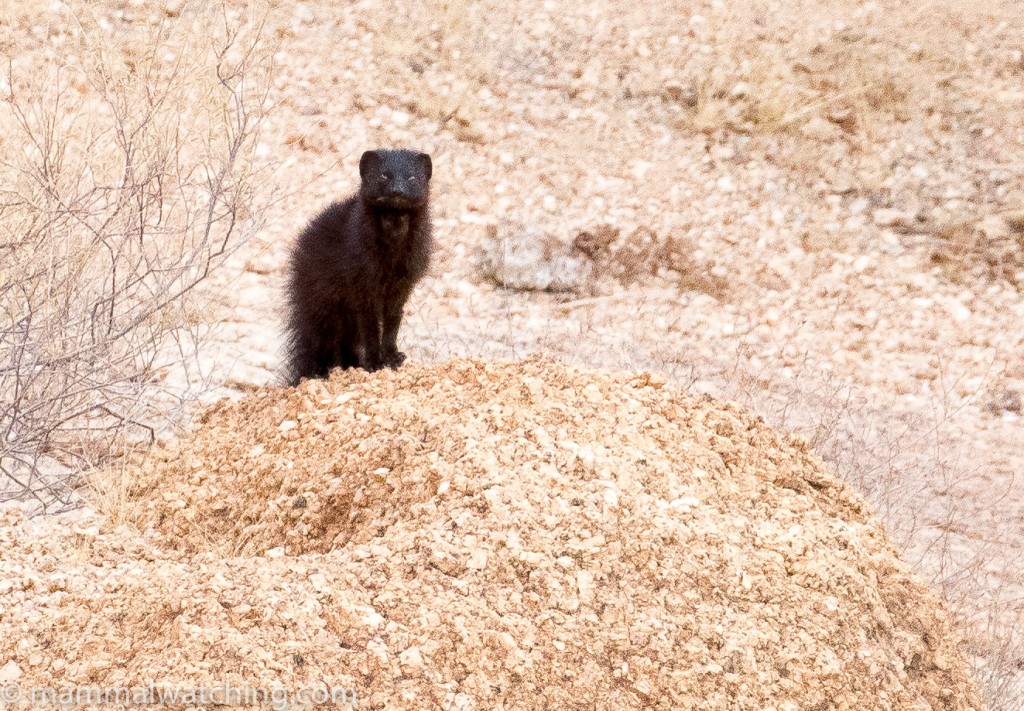
Black Mongoose, Galerella nigrata
6 Comments
-
AfriBats
Lovely report, Jon! You may anticipate what comes next: yes, indeed, an invitation to share some of it with AfriBats! We would be delighted, and it only takes a few minutes now that you’re an iNat pro.
-
AfriBats
Many thanks for sharing the bat observations, which can be found here http://www.inaturalist.org/observations?place_id=7140&subview=grid&user_id=jonhall100.
Also adding 2 links to papers dealing with the bats of Arnhem Cave:
https://doi.org/10.1080/0035919X.2014.999734
https://hdl.handle.net/10520/EJC117031
-
-
-
Leave a Reply
You must be logged in to post a comment.


paul carter
Hi Jon, Great report; having been through Namibia a couples of times for geology it is on my mind to go back for mammals so it was great to read on some of the spots you mentioned. The bat cave sounds excellent. Cheers, Paul